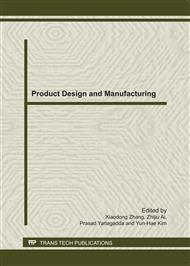p.355
p.360
p.365
p.369
p.375
p.380
p.384
p.388
p.392
Damage Modes Detection of Composite Laminates Using Improved Modal Strain Energy Method
Abstract:
Damage causes changes in structural parameters, which in turn, modify dynamic properties, such as natural frequencies and mode shapes. Based on this assumption, this paper presents a new approach to detect different damage modes of composite laminates. Finite element modal analysis is performed on the composite laminate to obtain the modal mode shapes used to compute the modal strain energy. Consequently, an improved damage index is defined by using the ratio of modal strain energies of composite laminates before and after damage. The proposed method is validated using a numerical simulation of a composite laminate with damages in some elements, which are simulated by reducing elements’ material stiffness properties under a combined material properties degradation rule. The result shows that six kinds of damage modes of composite laminates can be detected by this method preferably and give a qualitative description for the damage level.
Info:
Periodical:
Pages:
375-379
Citation:
Online since:
September 2011
Authors:
Price:
Сopyright:
© 2011 Trans Tech Publications Ltd. All Rights Reserved
Share:
Citation:


